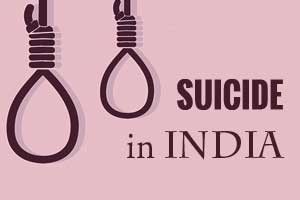- Home
- Editorial
- News
- Practice Guidelines
- Anesthesiology Guidelines
- Cancer Guidelines
- Cardiac Sciences Guidelines
- Critical Care Guidelines
- Dentistry Guidelines
- Dermatology Guidelines
- Diabetes and Endo Guidelines
- Diagnostics Guidelines
- ENT Guidelines
- Featured Practice Guidelines
- Gastroenterology Guidelines
- Geriatrics Guidelines
- Medicine Guidelines
- Nephrology Guidelines
- Neurosciences Guidelines
- Obs and Gynae Guidelines
- Ophthalmology Guidelines
- Orthopaedics Guidelines
- Paediatrics Guidelines
- Psychiatry Guidelines
- Pulmonology Guidelines
- Radiology Guidelines
- Surgery Guidelines
- Urology Guidelines
Suicide ranks first as cause of death among young adults in India: Lancet

An alarming study published in The Lancet finds that India accounts for about 37% of global suicide deaths among women and 24% among men. 63% of all such deaths reported in the country were in the age group of 15-39 years.
The Global Burden of Disease Study 1990-2016 said suicide ranked first in India as the cause of death compared to its third rank globally in this age group of 15-39 years.
A systematic understanding of suicide mortality trends over time at the subnational level for India's 1·3 billion people, 18% of the global population, is not readily available. Thus, Professor Rakhi Dandona from the Public Health Foundation of India, and colleagues conducted the study to report time trends of suicide deaths, and the heterogeneity in its distribution between the states of India from 1990 to 2016.
Married women account for the high proportion of suicide deaths in India, the study stated.
"The proportion of global suicide deaths in India has increased since 1990 for both sexes, but more for women than for men. Young adults are taking their own lives in alarmingly high numbers, constituting a public health crisis. Suicide ranks first as the cause of death in India in both the age groups of 15–29 years and 15–39 years, as compared with its second and third rank globally in these age groups, respectively," write the authors.
As a part of the study, the researchers estimated suicide death rates (SDRs) for both sexes in each state of India from 1990 to 2016. Various data sources were used for estimating cause-specific mortality in India.
For each state, they calculated the ratio of the observed SDR to the rate expected in geographies globally with similar GBD Socio-demographic Index in 2016 (ie, the observed-to-expected ratio); and assessed the age distribution of suicide deaths, and the men-to-women ratio of SDR over time. Finally, the probability for India and the states of reaching the Sustainable Development Goal (SDG) target of a one-third reduction in SDR from 2015 to 2030 was assessed using location-wise trends of the age-standardized SDR from 1990 to 2016.
Key Findings:
- There were 230 314 (95% UI 194 058–250 260) suicide deaths in India in 2016.
- India's contribution to global suicide deaths increased from 25·3% in 1990 to 36·6% in 2016 among women, and from 18·7% to 24·3% among men.
- Age-standardized SDR among women in India reduced by 26·7% from 20·0 (95% UI 16·5–23·5) in 1990 to 14·7 (13·1–16·2) per 100 000 in 2016, but the age-standardized SDR among men was the same in 1990 (22·3 [95% UI 14·4–27·4] per 100 000) and 2016 (21·2 [14·6–23·6] per 100 000).
- SDR in women was 2·1 times higher in India than the global average in 2016, and the observed-to-expected ratio was 2·74, ranging from 0·45 to 4·54 between the states.
- SDR in men was 1·4 times higher in India than the global average in 2016, with an observed-to-expected ratio of 1·31, ranging from 0·40 to 2·42 between the states.
- There was a ten-fold variation between the states in the SDR for women and six-fold variation for men in 2016.
- The men-to-women ratio of SDR for India was 1·34 in 2016, ranging from 0·97 to 4·11 between the states.
- The highest age-specific SDRs among women in 2016 were for ages 15–29 years and 75 years or older, and among men for ages 75 years or older.
- Suicide was the leading cause of death in India in 2016 for those aged 15–39 years; 71·2% of the suicide deaths among women and 57·7% among men were in this age group.
The study found wide variations in dsease related death rate across states in India.
Karnataka, Tamil Nadu, Andhra Pradesh, Telangana, West Bengal, and Tripura had high suicide death rates for both men and women, in addition to Kerala and Chhattisgarh which had high suicide death rates for men.
"The disproportionately high suicide deaths in India are a public health crisis. Suicide ranks as the leading cause of death among young adults in India and suicides among women need particular attention."
"A national prevention strategy for it is needed as a guide, which then has to be adopted at the state level to take into account the wide variations in trends between the states and the context of each state to reduce the burden of suicide deaths in India," they conclude.
For further reference follow the link: https://doi.org/10.1016/S2468-2667(18)30138-5

Disclaimer: This site is primarily intended for healthcare professionals. Any content/information on this website does not replace the advice of medical and/or health professionals and should not be construed as medical/diagnostic advice/endorsement or prescription. Use of this site is subject to our terms of use, privacy policy, advertisement policy. © 2020 Minerva Medical Treatment Pvt Ltd